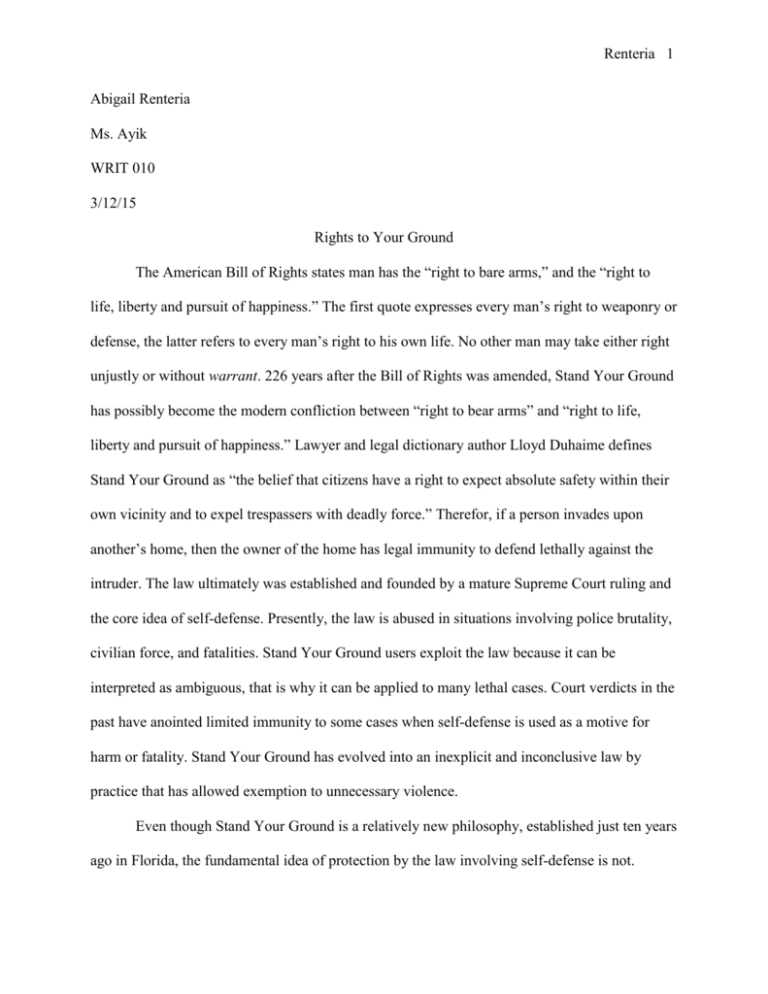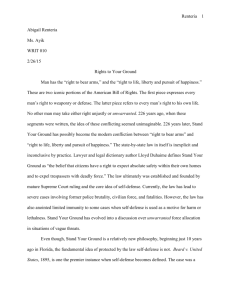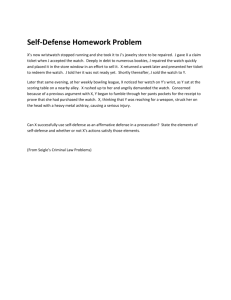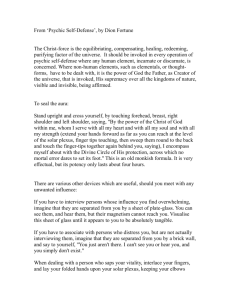Right to Your Ground Draft #3
advertisement

Renteria 1 Abigail Renteria Ms. Ayik WRIT 010 3/12/15 Rights to Your Ground The American Bill of Rights states man has the “right to bare arms,” and the “right to life, liberty and pursuit of happiness.” The first quote expresses every man’s right to weaponry or defense, the latter refers to every man’s right to his own life. No other man may take either right unjustly or without warrant. 226 years after the Bill of Rights was amended, Stand Your Ground has possibly become the modern confliction between “right to bear arms” and “right to life, liberty and pursuit of happiness.” Lawyer and legal dictionary author Lloyd Duhaime defines Stand Your Ground as “the belief that citizens have a right to expect absolute safety within their own vicinity and to expel trespassers with deadly force.” Therefor, if a person invades upon another’s home, then the owner of the home has legal immunity to defend lethally against the intruder. The law ultimately was established and founded by a mature Supreme Court ruling and the core idea of self-defense. Presently, the law is abused in situations involving police brutality, civilian force, and fatalities. Stand Your Ground users exploit the law because it can be interpreted as ambiguous, that is why it can be applied to many lethal cases. Court verdicts in the past have anointed limited immunity to some cases when self-defense is used as a motive for harm or fatality. Stand Your Ground has evolved into an inexplicit and inconclusive law by practice that has allowed exemption to unnecessary violence. Even though Stand Your Ground is a relatively new philosophy, established just ten years ago in Florida, the fundamental idea of protection by the law involving self-defense is not. Renteria 2 Beard v. United States, 1895, is the first legal precedent when self-defense becomes defined by law. The case was a family feud over the inheritance of a cow. It developed into a brawl from the feud: threats turned into guarantees, and shots were fired for trespassing. The significance of the case comes from the Supreme Court opinion affirming that a self-defender “is not obliged to retreat, but may stand his ground and defend himself with such means as are within his control; and so long as there is no intent on his part to kill his antagonist, and no purpose of doing anything beyond what is necessary to save his own life, is not guilty of murder.” Self-defense is unclear and blurred in the verdict, but obvious. There is a lack of transparency in the definition of the term self-defense converges with Stand Your Ground’s elusive definition stated previously. The opinion even uses “stand his ground”. After all, the defendant was on his own land. Whether the cow was his or not, he was in fact standing his ground, his own ground. The defendant shooting the victim was not considered “anything beyond what is necessary to save his own life.” He was merely standing his ground as stated in the judgment by the Supreme Court. What the defendant did to receive this verdict and have the declaration of self-defense is unclear, because there is no criteria or formula given. Self-defense is defined as ambiguous. Self-defense did not progress into Stand Your Ground immediately or rapidly. However, it did develop from the Castle Doctrine first. Eventually, Stand Your Ground came as a product of the two. The Castle Doctrine contrasts Stand Your Ground by location and position. Brendan Purves, a writer for Southern Source, agrees that Stand Your Ground is typically unspecified in where the utilizer can defend oneself. The law states as long as the utilizer is within a place he or she has a right to be immunity to violence is given. In comparison, the location is explicit and clear in which the Castle Doctrine may be applied. The law focuses on homes and cars as places where legal immunity can be given in cases of extraordinary measures (Purves). The Castle Renteria 3 Doctrine and Stand Your Ground share their divergence from self-defense but differ in location. This comparison underlines the confusion and uncertainty in Stand Your Ground’s definition since no location is indicated. Trayvon Martin, Chad Oulson, and Kelly Danahar are all recent fatalities linked to the Stand Your Ground law in their state. Kelly Danahar was hosting a birthday party for his daughter and intimate friends. His neighbor, Raul Rodriguez, complained formally to the local police several times about the noise coming from the party. The noise, however, continued to come from the party. Rodriguez seized control of the situation. He showed up at Danahar’s home with a gun. After a disagreement Rodriguez ends up firing his gun and shooting three members of the party: Ricky Johnson, Marshall Steston, and Kelly Danahar. The fatal shooting left the father, Kelly Danahar, to bleed out. Rodriguez pleaded Texas’ Stand Your Ground law: he claimed he was only acting in self-defense. Rodriguez appealed saying some of the guests were going to harm him. The plea did not affect the case. Raul Rodriguez was sent to forty years in prison (Stangeland). Trayvon Martin had an encounter like Kelly Danahar, but it ended with a very different conclusion. The well-known story begins as a young man walks home from a convenience store in Florida late at night. Martin was being followed by George Zimmerman, a neighborhood watch volunteer. Zimmerman was suspicious of Martin, who was aimlessly walking down the street, so he contacted the police, who advised him not to follow Martin. He ignored the recommendation by dispatch and continued to pursue. An argument ensued between Zimmerman and Martin soon after Martin discovered the neighborhood watch volunteer following close behind. Then, Zimmerman fired his gun; the shot killed Martin (Botelho). George Zimmerman was charged with second-degree murder but was acquitted recently. During his trial process, Renteria 4 Florida’s own Stand Your Ground law was ready to be used in Zimmerman’s favor (Gonzalez). The statute can be easily misused in a variety of cases, such as this one, because it is broad and vague. Chad Oulson became the most recent victim of the Stand Your Ground law. The middleaged man sat in a Florida movie theatre texting during the opening previews. He was messaging his daughter’s babysitter for the evening. Curtis Reeves, a retired police officer, found the act of texting in the movie theatre to be rude and unnecessary. Reeves commented to Oulson, and asked him to stop. An altercation began. The two argued, and popcorn was thrown according to witnesses at the theatre. Reeves, however, reached for his gun and shot Oulson in the front of the movie-goers (Buie). The former cop, Reeves, claimed the act of violence was self-defense as well as Stand Your Ground. The authorities for this case plan to throw out Reeve’s Stand Your Ground case. Yet, there is a chance the law may stay in motion. Reeve’s trial has not taken place yet as of February 2015 (Almasy and Payne). The significance of these three stories is not their tragic deaths, but is the aftermath of each trial. The outcome was different in each circumstance. The acquisition, conviction, or still to be determined. Yet, in each case the defendant used Stand Your Ground. Since the law is indefinite it was applicable to three different and unique trials. The law can lead to future misuse of the statue since a variety of cases can use it. Laws evolve from many sources, modern or historical. Stand Your Ground is related to the Bill of Rights because of its controversy involving the right to bare arms and to defend life, liberty and pursuit of happiness. The law has some relic behind it. Stand Your Ground pulls from self-defense ideals as well as the Castle Doctrine thinking. Yet, the law is a more modern and controversial topic. Tampa Bay Times states that since the statue’s existence in 2005, it has been Renteria 5 used at minimum 130 times. With Trayvon Martin, Chad Oulson, and Kelly Danahar a different trial and ending was experienced involving Stand Your Ground. Therefor, a different trial and ending must have been experienced for the other 127 situations. The adaption of self-defense would ultimately be responsible for the variations in outcomes. Stand Your Ground is vague. By the cases mentioned, the statue is proven as widely acknowledged in a variety of situations due to the lack of clarity. The criterion to use Stand Your Ground is whether or not the utilizer has a right to be in one place or not. Uncertainty lingers in the law. Nevertheless, these are not just laws being discussed; fatalities are just as inclusive as well. After all, we all have nothing but rights to the ground. Renteria 6 Works Cited Angione, Joe. "Stand Your Ground ... save Your Life - Watchdog Wire - Florida." Watchdog Wire. Franklin Center for Government & Public Integrity, 01 Aug. 2013. Web. 24 Feb. 2015. "Beard v. United States 158 U.S. 550 (1895)." Justia Law Supreme Court. Justia Law, n.d. Web. 24 Feb. 2015. Botelho, Greg. "What Happened the Night Trayvon Martin Died - CNN.com." CNN. Cable News Network, 23 May 2012. Web. 24 Feb. 2015. Buie, Lisa. "Pasco Man Claims Curtis Reeves Told Him to 'shut Up' in a Theater 8 Years Ago." Tampa Bay Times. Tampa Bay Times, 8 Sept. 2014. Web. 24 Feb. 2015. Duhaime, Lloyd. "Stand Your Ground Legal Definition:." Stand Your Ground Legal Definition. Lloyd Duhaime, n.d. Web. 24 Feb. 2015. Gonzalez, Robert. "George Zimmerman's Attorneys Won't Use "stand Your Ground" Defense." CBSNews. CBS Interactive, 13 Aug. 2012. Web. 24 Feb. 2015. Payne, Ed, and Steve Almasy. "Florida Theater Shooting: Couple Describes Encounter with Curtis Reeves - CNN.com." CNN. Cable News Network, 15 Jan. 2014. Web. 24 Feb. 2015. Purves, Brendan. "Castle Doctrine from State to State." South Source. South University, n.d. Web. 24 Feb. 2015. Stangeland, Brooke. "Self-Defense or Murder? What Drove Man to Kill Neighbor." ABC News. ABC News Network, 14 Sept. 2012. Web. 24 Feb. 2015. "States That Have Stand Your Ground Laws - FindLaw." FindLaw. FindLaw, n.d. Web. 24 Feb. 2015. Renteria 7 United States. Continental Congress. Extracts from the Votes and Proceedings of the American Continental Congress Held at Philadelphia on the 5th of September 1774. Containing the Bill of Rights, a List of Grievances, Occasional Resolves, the Association, an Address to the People of Great-Britain, and a Memorial to the Inhabitants of the British American Colonies. Published by Order of the Congress. By Benjamin Edes, John Gill, Thomas Fleet, and John Fleet. Boston: Philadelphia, 1774. Print. Volokh, Eugene. "Duty to Retreat and Stand Your Ground: Counting the States." The Volokh Conspiracy. The Volokh Conspiracy, 17 July 2013. Web. 24 Feb. 2015. Winch, Graham. "Are You Living in a 'Stand Your Ground' State?" HLNtv.com. Time Warner Company, 20 Feb. 2014. Web. 24 Feb. 2015.




